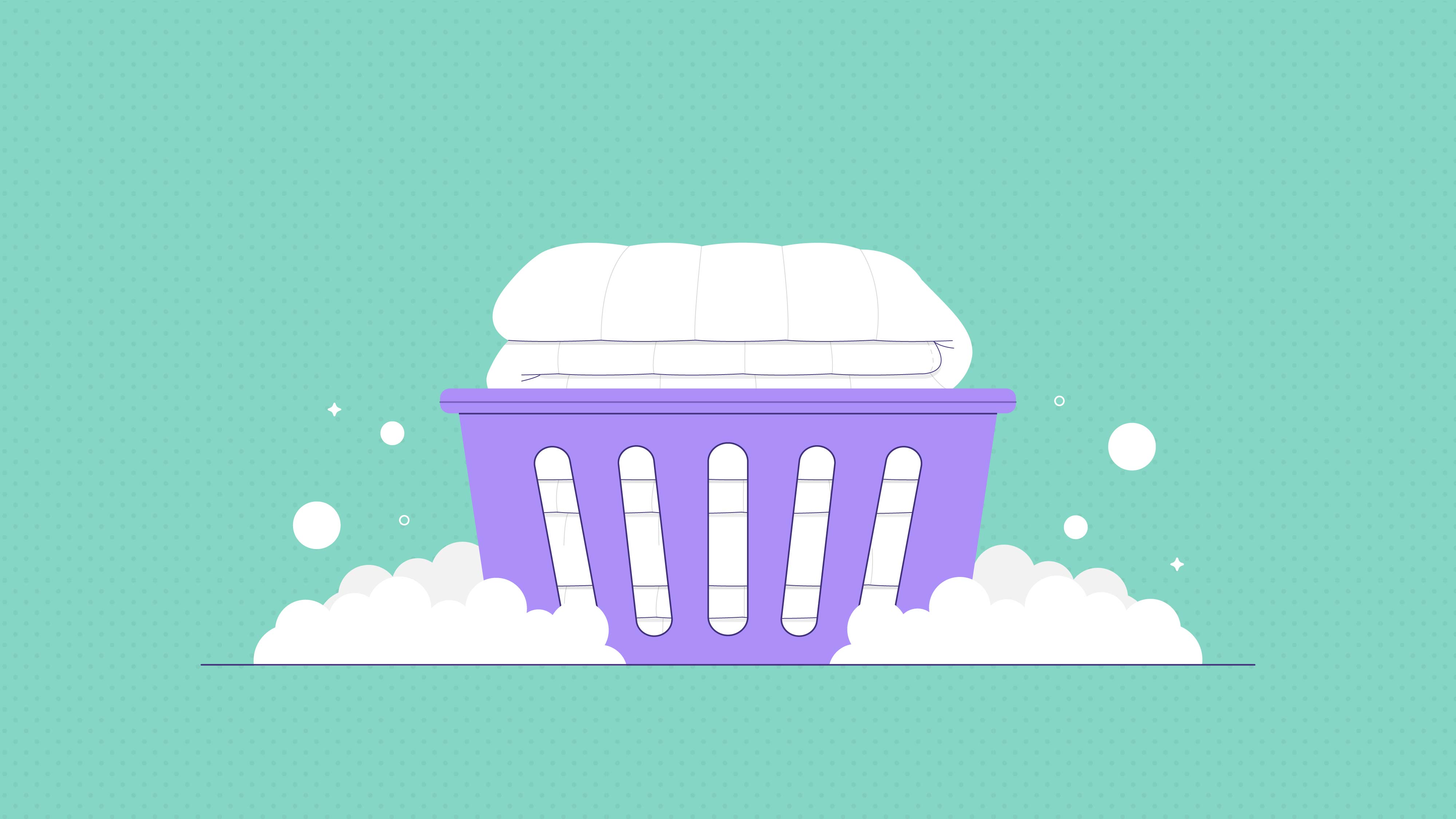
How to Wash a Comforter

Your comforter may be harboring dust mites and other indoor allergens, so washing them is a must. Like sheets and pillowcases, comforters and duvets can be a breeding ground for allergens, which may trigger symptoms such as wheezing, coughing, and sneezing, causing sleep disruptions.
To avoid these sleep disruptions, it’s best to wash your bedding accessories regularly. Washing a bulky comforter may be challenging, but it’s not impossible.
While most types of fills can be machine washed, some may require professional dry cleaning. In this article, we discuss the different types of comforters, how to wash and dry them, and how frequently you should do so.
Types of Comforters
While there are different types of fill materials available on the market, down and polyester (down alternatives) are the most common. Comforters with these types of fills are machine washable, but other materials such as wool and silk need to be dry-cleaned.
Down
Down refers to the fluffy feathers beneath the wings of ducks and geese. This soft and warm material is a popular fill for comforters and duvet inserts, but traces of dust in the down may trigger allergies in some people. Contrary to popular belief, even down comforters can be machine washed in cold water.
Down Alternative
Down alternative feels like down, but it’s made with synthetic materials, appealing to allergy sufferers. Down alternative is also much less expensive than down. While most comforters are washed in cold water, down alternative comforters can be washed in warm water at 120 degrees. High temperatures are preferred because they effectively kill allergens.
Cotton
Comforters stuffed with this natural material are soft and breathable. Cotton comforters are not as thick as polyester ones, so they are generally used during the summer months. They are easy to maintain and can be washed in cold or warm water.
Lyocell
Lyocell is derived from the wood cellulose of eucalyptus or bamboo trees. This eco-friendly material is soft and absorbent, wicking away moisture from your body. These comforters should be washed in cold water because high temperatures may cause shrinkage.
Wool
Wool comforters are heavier than other fill types and popular during the winter months. Most wool comforters cannot be machine washed because doing so damages the texture.
Silk
This natural fiber spun from the silkworm is the most expensive of all fill types. Silk filled comforters are lightweight, breathable, and luxurious. Silk is naturally antibacterial, making it a perfect option for those prone to allergies, but cleaning these comforters may be difficult. Some need professional dry cleaning, while others can be hand washed.
How to Wash a Comforter
Before you wash a comforter, check the instructions on the care label. If machine washing is permitted, manufacturers often specify the water temperature and washing cycle settings. This helps to maintain the quality of the fill and the fabric cover.
To prevent tears during washing, ensure there are no open seams or loose threads dangling from your comforter. If you notice any tears, stitch them up before washing your comforter. After completing these pre-wash measures, take the following steps to keep your comforter clean and prolong its life.
Spot Clean Stains, If Any
If you notice any stains on your comforter, shift the underlying fill material as much as possible, so you work only on the fabric. Take a soft, damp, white cloth and lightly rub on the stained area. Use inward circular motions to avoid spreading the stain further.
Sprinkle a small amount of baking soda on the stain or apply mild laundry detergent and let it rest for 10 minutes. Then scrub off the stain with another clean, damp cloth. It’s best to spot clean stains as soon as you notice them, otherwise, they might set.
Try to Fit Your Comforter in the Washing Machine
Comforters are bulky and stuffing them in small washing machines compresses the fill, damaging them. Loosely stuff your comforter in the washing machine, leaving at least 20 percent of space in the drum.
If your home washing machine does not have enough space, don’t cram the comforter inside it. Instead, take it to the local laundromat where large washers and dryers are available. Even if there is space in the washer drum, do not add any other items to your load. During the washing process, comforters need space to get cleaned properly.
Use the Right Detergent and Wash Cycle
Use a mild liquid detergent because they are gentle on the fabric, keeping them smooth for long. Sometimes care instructions may mention a particular type of detergent, best for the specific fill or fabric cover.

After adding the detergent, set it on a delicate or gentle cycle. If possible, add the “extra rinse” option to ensure there’s no remaining detergent on the comforter. Soap residues cause fill clumping, making your comforter lumpy in some areas and too thin in other parts.
If your washer does not have the “extra rinse” option, run your fingers through the wet comforter to check for detergent remnants. If you find any, wash the comforter again on a delicate cycle without detergent.
Handwash the Comforter
Some materials such as silk and wool need handwashing because the delicate strands may break down due to the washer’s rigorous motion. Handwash these comforters in your bathtub, but before doing so, clean your tub so the germs don’t stick to your comforter. Then fill the tub with cold water and add a mild detergent. Swirl it with your hand to make a soapy solution.
Fully immerse your comforter in the soapy solution and let it rest for 10 minutes. Then drain the tub while gently pressing down the comforter. Avoid wringing it because doing so compresses the fill, potentially damaging your comforter. Fill the tub again with cold water and continue pressing the comforter to rinse it well.
How to Dry a Comforter
After washing your comforter, give it a good shake to speed up the drying process. Then put the comforter in a large capacity dryer and throw in a few tennis balls or wool balls. These dryer balls move around during the drying process, preventing fill clumping.
Tumble dry on no heat or low heat settings, because this is a gentle method to prevent your comforter from wearing out. Since comforters are bulky, drying them in low temperatures may take 2 to 3 hours. Check on it every half hour to ensure it’s dried thoroughly because any trace of moisture may lead to mold and mildew growth.
Once you take it out of the dryer, it might be a good idea to air-dry the comforter for a couple of hours. Hang it on a clothesline so the heat from the sun absorbs any remaining dampness. The sun’s UV rays can also kill viruses and germs lurking in your comforter.
Frequency of Washing a Comforter
If you use a duvet cover with your comforter or duvet insert, then washing them once every 2 years is enough to keep them clean. Machine wash the removable covers once every 1-2 weeks to keep your bedding clean.
In case you don’t use a duvet cover with your comforter, wash the comforter every 6 months to keep it clean. As a reminder, we suggest washing your sheets every week,
FAQs
Are you supposed to wash a comforter?
Yes, washing a comforter is necessary to keep your bed clean and free of allergens. Allergic reactions can interrupt sleep, so wash your comforter every few weeks to keep it in good condition.
How do you wash a large comforter?
Cramming the washer drum with a large comforter compresses the fill, ruining your comforter. Either hand wash it in your bathtub or take it to the local laundromat and wash it on the delicate setting. Always follow the care instructions on the comforter tag for the best cleaning practices.
Can I put my comforter in the dryer?
Yes, but ensure it’s a large capacity dryer, otherwise, the comforter’s filling will get compressed and break down. Spread the comforter out and add clean tennis balls or wool dryer balls to prevent fill clumping. Run the dryer on a no heat or low heat setting for 2 to 3 hours. Once the dry cycle is complete, pull the comforter out and give it a gentle fluff to keep the fill evenly distributed.
Can I wash a queen comforter in my washer?
Yes, most queen comforters can be washed in a home washing machine. Queen comforters usually weigh around 6 to 10 pounds and most home washing machines are capable of handling 10 to 14 pounds of laundry. However, don’t add any other items in with the comforter, because they need space to rotate in the washer drum.
How often should you wash a comforter?
We recommend washing the cover once or twice a month, and the insert every 1-2 years (unless you spill something on it).
Conclusion
Some comforters are more difficult to wash due to their size and fill type, so using a duvet cover is helpful because it reduces the frequency of washing. To maintain cleanliness between washings, air out your comforter monthly by hanging it on a clothesline, or out in the sun for a couple of hours. The heat from the sun absorbs traces of sweat and kills allergens, providing you with a clean and fluffy comforter.
